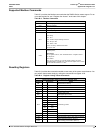
© 2011 Schneider Electric. All Rights Reserved.
63230-500-225A2 PowerLogic
TM
Series 800 Power Meter
3/2011 Appendix C—Using the Command Interface
83
Appendix C—Using the Command Interface
Overview of the Command Interface
The power meter provides a command interface, which can be used to issue commands
that perform various operations such as controlling relays. Table C–1 lists the definitions for
the registers.Table C–2 lists the available commands. The command interface is located in
memory at registers 8000–8149.
When registers 8017 through 8019 are set to zero, no values are returned. When any or all
of these registers contain a value, the value in the register “points” to a target register,
which contains the status, error code, or I/O data (depending on the command) when the
command is executed. Figure C–1 shows how these registers work.
NOTE: You determine the register location where results will be written. Therefore, take
care when assigning register values in the pointer registers; values may be corrupted when
two commands use the same register.
Refer to “Register List Access” on page 79 for instructions on accessing the complete register list.
Table C–1: Location of the command interface
Register Description
8000 This is the register where you write the commands.
8001–8015
These are the registers where you write the parameters for a
command. Commands can have up to 15 parameters associated with
them.
8017
Command pointer. This register holds the register number where the
most recently entered command is stored.
8018
Results pointer. This register holds the register number where the
results of the most recently entered command are stored.
8019
I/O data pointer. Use this register to point to data buffer registers
where you can send additional data or return data.
8020–8149
These registers are for you (the user) to write information. Depending
on which pointer places the information in the register, the register can
contain status (from pointer 8017), results (from pointer 8018), or data
(from pointer 8019). The registers will contain information such as
whether the function is enabled or disabled, set to fill and hold, start
and stop times, logging intervals, and so forth.
By default, return data will start at 8020 unless you specify otherwise.
Figure C–1: Command interface pointer registers
8020
1
(status of the
last command)
Register 8017
Register 8020
8021
51
(error code caused by
the last command)
Register 8018
Register 8021
8022
0
(data returned by the
last command)
Register 8019
Register 8022


















